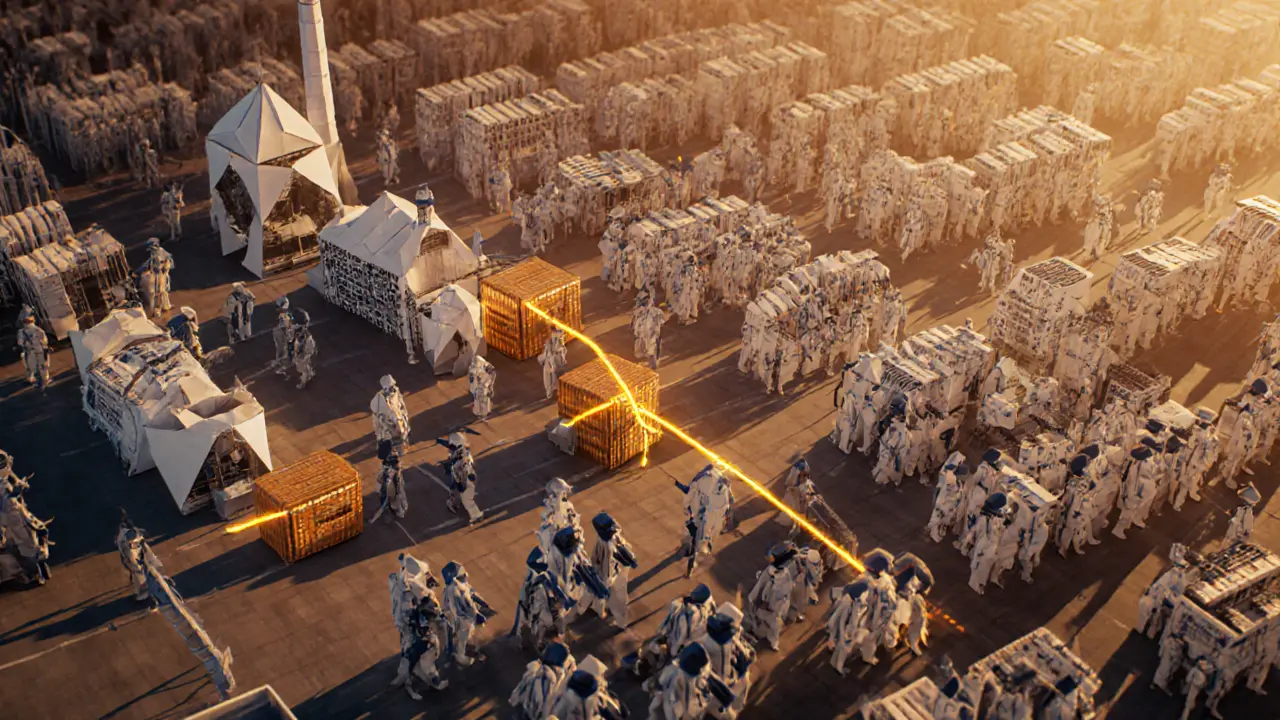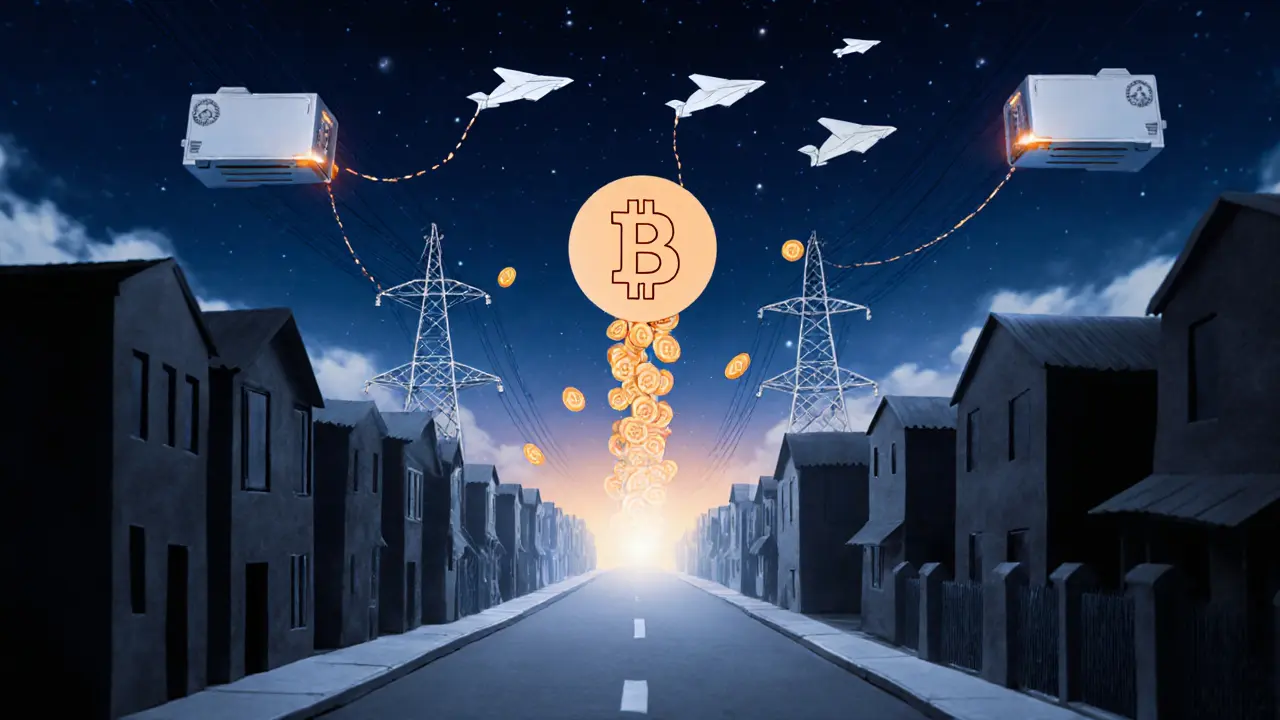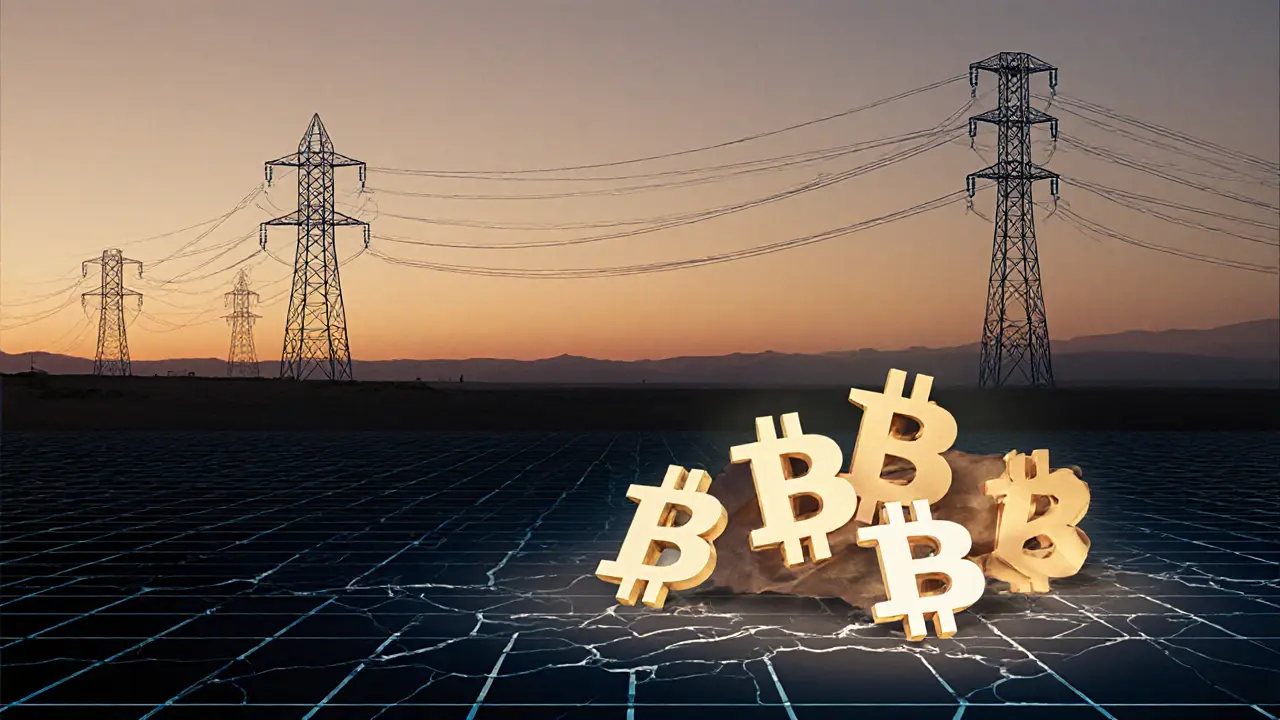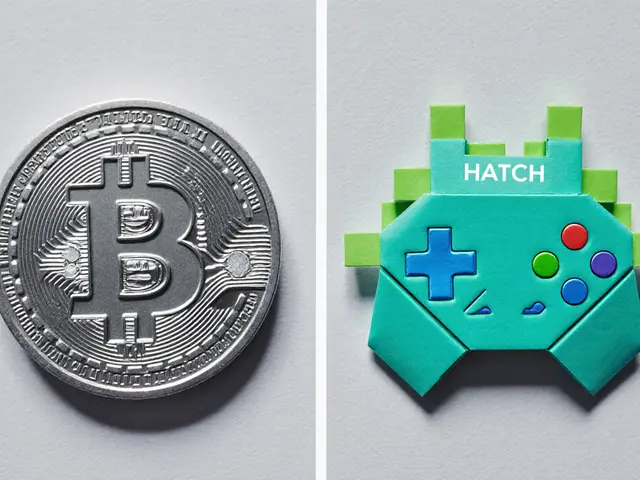IRGC Crypto Mining Impact Calculator
Licensed Mining
Electricity Cost: High market tariff
Regulation: Monthly reporting to CBI
Profit: Often negative after fees
Scale: Typically < 5 MW
Unlicensed IRGC Mining
Electricity Cost: Subsidized/free
Regulation: Minimal, military protection
Profit: High due to low energy cost
Scale: Often > 50 MW
Estimated Impact of IRGC Mining
Total Power Consumption: 0 GW
Percentage of National Grid Load: 0%
Estimated Daily Outages for Civilians: 0 hours
Estimated Annual Revenue for IRGC: $0
When Iran’s economy was squeezed by tightening sanctions, the IRGC cryptocurrency mining operation quietly grew into a massive, state‑backed cartel that guzzles electricity and fuels the regime’s cash flow. The story isn’t about hobbyists or start‑ups; it’s about a military‑industrial complex that turned illegal Bitcoin farms into a strategic weapon against external pressure.
Sanctions, Power Shortages, and the Crypto Hook
International sanctions in the late 2010s cut off Iran’s access to traditional dollar channels. Iran a middle‑east nation under U.S. and EU financial restrictions needed an alternative way to move value. Cryptocurrency offered exactly that: direct, peer‑to‑peer transfers that bypass banks and hide the origin of funds.
At the same time, the country faced a chronic energy crisis. Power outages were already common, and the grid’s inefficiencies left a huge amount of subsidized electricity idle. The regime recognized a perfect match - cheap, abundant power paired with a digital asset that could circumvent sanctions.
The IRGC’s Strategic Takeover
IRGC the Islamic Revolutionary Guard Corps, Iran’s powerful paramilitary and economic organization entered the crypto arena around 2019‑2020 under direct orders from Supreme Leader Ali Khamenei Iran’s supreme leader who oversees the IRGC. The goal was clear: turn the nation’s electricity surplus into Bitcoin revenue.
Key to the plan was partnering with foreign firms, especially Chinese investors who supplied mining hardware and technical know‑how. The most visible example is the Rafsanjan Bitcoin farm a 175‑megawatt mining facility in Kerman Province. Officially presented as a joint venture, the farm sits inside a special economic zone guarded by IRGC forces and receives electricity at near‑zero cost.
Scale: Numbers That Shock
Estimates suggest Iran operates roughly 180,000 mining devices ASIC miners used for Bitcoin production. Private miners own about 80,000 units; the remaining 100,000 are believed to be under IRGC‑linked entities. This translates to an estimated 10-12% of the world’s Bitcoin hash rate coming from Iranian soil, according to blockchain analytics firms.
These machines sit in facilities owned by a mix of military‑run companies, the charitable trust Astan Quds Razavi a massive bonyad supervised by the Supreme Leader, and several lesser‑known enterprises all reporting to the Guard. Their power consumption rivals that of a small city, often leading to rolling blackouts in nearby towns.

Why Private Miners Can’t Compete
Legally, Iran recognized crypto mining in 2019, handing out licenses through the Ministry of Industry, Mines and Trade the government body that issues mining permits. But licensed miners face steep electricity tariffs and must sell their output to the Central Bank of Iran (CBI) the country’s monetary authority at a government‑set rate. The net profit margin barely covers operating costs.
In contrast, IRGC‑backed farms receive power free of charge, enjoy armed protection, and can bypass tax checks entirely. When the parliament in 2022 quietly allowed the military to build private power plants, the Guard gained its own dedicated grid, further insulating its operations from civilian oversight.
Economic and Social Fallout
The energy drain is palpable. Energy Minister Ali Abadi a former IRGC commander turned minister publicly called unauthorized crypto mines “an ugly theft,” yet his own background fuels speculation that the state won’t crack down on its own troops.
Households report up to six hours of daily outages, factories shutter for days, and hospitals rely on costly diesel generators. All the while, the Guard’s Bitcoin farms keep churning out coins that are quickly moved to offshore wallets, often linked to proxy groups in the region.
Regulatory Tug‑of‑War
In December 2024, the CBI attempted to curb crypto flow by blocking all domestic‑to‑foreign currency conversions on internet platforms. By January 2025, the bank introduced a government‑run API that grants privileged exchanges full access to user data, effectively turning the market into a surveillance zone. However, the IRGC sidesteps these controls by moving coins through private wallets and overseas exchanges, a loophole that remains largely untouched.
Popular local exchange Nobitex Iran’s largest domestic crypto exchange continues to operate under strict limits, while many Iranians resort to VPNs and foreign platforms to trade.

International Reaction
U.S. Treasury and Israeli intelligence have singled out Bitcoin addresses linked to the Guard, freezing assets and sanctioning front companies. Yet the decentralized nature of blockchain means the funds can be recirculated through mixers, making enforcement a cat‑and‑mouse game.
Beyond sanctions, the global crypto community is watching Iran as a case study of how state actors can weaponize digital assets to fund conflict and evade financial isolation.
Comparison: Licensed vs Unlicensed Mining in Iran
| Aspect | Licensed (Ministry‑approved) | Unlicensed (IRGC‑linked) |
|---|---|---|
| Electricity Cost | Market tariff (high) | Subsidized / free |
| Regulatory Oversight | Monthly reporting to CBI | Minimal, military protection |
| Profit Margin | Often negative after fees | High, due to low energy cost |
| Legal Risk | Subject to fines, shutdowns | Immune due to political ties |
| Scale of Operations | Typically < 5MW farms | Often > 50MW, some 175MW sites |
Looking Ahead: What Might Change?
Three scenarios dominate the near‑future outlook:
- Intensified sanctions. If the U.S. and EU expand crypto‑focused penalties, the Guard could double down on covert mining, further degrading the civilian power grid.
- Domestic crackdown. A genuine political shift could see the parliament empower civilian regulators to seize illegal farms, but this would require dismantling the Guard’s entrenched energy assets.
- Technological disruption. A shift to energy‑efficient proof‑of‑stake blockchains could render Bitcoin farms less profitable, potentially lowering the incentive for large‑scale mining.
Until one of these forces takes hold, Iran’s energy crisis and crypto‑driven cash flow will likely remain intertwined.
Frequently Asked Questions
Why does the IRGC focus on Bitcoin rather than other cryptocurrencies?
Bitcoin remains the most liquid and widely accepted cryptocurrency on the global market. Its high market cap and mature exchange network make it easier to convert into cash or fiat, which is essential for bypassing sanctions.
How much electricity does the IRGC’s mining consume compared to Iran’s total consumption?
Estimates place IRGC‑linked farms at roughly 2-3GW of continuous load, which is about 5-7% of Iran’s total electricity generation capacity. Because the power is taken from the national grid, the impact on civilian supply is disproportionately large.
Can ordinary Iranians still mine cryptocurrency legally?
Yes, but they must obtain a license from the Ministry of Industry, Mines and Trade, pay high electricity tariffs, and sell any mined coins to the Central Bank at a fixed rate. These conditions make small‑scale mining economically unviable for most citizens.
What international actions are being taken against the IRGC’s crypto activities?
The U.S. Treasury has designated several IRGC‑linked wallets under sanctions, freezing any assets they touch. Israeli intelligence also monitors these addresses, sharing intel with allied financial watchdogs. However, the effectiveness is limited by the anonymity built into blockchain transactions.
Will Iran’s energy crisis improve if the mining farms shut down?
In theory, freeing 2-3GW of power would reduce load on the grid, lowering outage frequency. But without structural reforms to the national grid and subsidy system, the overall crisis would persist.





Kimberly Kempken
IRGC hijacking electricity is a perfect example of state‑run corruption.
Eva Lee
The Guard’s crypto farms are basically a black‑market energy arbitrage, leveraging subsidized grid access to undercut legitimate miners and create a distortion in the market dynamics. This black‑ops use of capacity factor and load‑shedding tactics showcases a blatant abuse of state resources.
Carthach Ó Maonaigh
What a shameless power‑grab-these militarized miners are basically leeching the nation’s grid while civilians get the short end of the stick, and anyone who defends it is either clueless or complicit.
Brooklyn O'Neill
I think it’s important we highlight how these unlicensed operations siphon resources that could otherwise support local communities and essential services.
Greer Pitts
yeah totally, the grid’s already stretched thin and these rigs just make things worse for everyday folks.
Lurline Wiese
It's infuriating to watch the IRGC turn a national crisis into a personal crypto jackpot, all while the lights flicker on the streets below.
Jenise Williams-Green
Honestly, it’s a moral outrage when a militarized institution profits from the suffering of its own citizens, and we can’t just sit back and cheer.
Laurie Kathiari
The sheer audacity of the Guard to operate massive mining farms under the guise of national security is a blatant abuse of power that undermines any claim to legitimacy.
Katherine Sparks
While this situation is certainly concerning, raising awareness and pushing for transparent energy policies could curb such exploitative practices 😊.
Ciaran Byrne
Agreed, policy reform is the key to protecting civilians from these needless outages.
Cynthia Rice
Free electricity for miners equals higher tariffs for everyone else.
Adarsh Menon
Oh great, the Guard’s new hobby is mining Bitcoin-because obviously the best way to keep the population happy is by cutting their power supply.
Jim Griffiths
One way to estimate the real impact is to compare the reported megawatt consumption of these farms against the national grid’s average load.
Matt Nguyen
It is imperative to consider that the unlicensed mining operations may serve as a covert revenue stream, funneling crypto profits into undisclosed channels that further entrench the regime’s financial opacity.
Promise Usoh
The phenomenon of state‑backed crypto mining in Iran presents a striking case study of how authoritarian regimes can co‑opt emerging technologies for personal enrichment.
By exploiting subsidized electricity, the IRGC effectively externalizes the cost of mining onto the public while internalizing the enormous profits.
This creates a perverse incentive structure where the ambition to generate digital wealth outweighs any consideration for civic welfare.
Moreover, the lack of transparent oversight means that the true scale of these operations remains shrouded in secrecy, hindering accurate assessment.
From an energy economics perspective, the diversion of tens of megawatts of power to high‑intensity mining rigs exacerbates grid stress, especially during peak demand periods.
Consequently, households experience more frequent load‑shedding events, which can have cascading effects on small businesses and essential services.
The financial gains reported by the Guard, albeit nominal in public statements, likely dwarf the marginal cost of electricity thanks to the government’s own price controls.
International sanctions further complicate the picture, as the regime seeks alternative revenue sources that bypass conventional banking restrictions.
Crypto mining, with its pseudo‑anonymity and global market, offers an attractive channel for evading sanctions while laundering proceeds.
Yet the domestic fallout is palpable: reduced reliability of the power supply undermines public trust and fuels resentment toward the authorities.
Scholars of political economy argue that such exploitation of public utilities is a hallmark of rent‑seeking behavior in autocratic systems.
In the long run, the sustainability of these mining farms is questionable, as the cumulative wear on infrastructure could precipitate costly failures.
Policy analysts suggest that imposing strict licensing and tariff reforms could mitigate the adverse effects on the civilian grid.
However, the likelihood of such reforms being enacted remains slim given the Guard’s entrenched interests and the opaque nature of its operations.
Ultimately, the IRGC’s unlicensed crypto mining serves as a vivid reminder that technological innovation can be wielded as a tool of oppression when placed in the hands of unchecked power.
Shaian Rawlins
I appreciate the comprehensive analysis laid out in the previous comment; it really underscores how energy policy and political motives intertwine in ways that ordinary citizens often overlook.
By framing the issue through both economic and ethical lenses, we can better advocate for reforms that prioritize public welfare over clandestine profit.
It’s crucial that we keep shedding light on these hidden operations, because ignorance only serves those who benefit from secrecy.
Let’s continue to push for transparent reporting and international scrutiny to hold the Guard accountable.
Together, informed discourse can become a catalyst for change.
Tyrone Tubero
It’s mind‑blowing how a single institution can turn a nation’s power grid into their personal crypto casino, gambling with the livelihoods of millions.
Natalie Rawley
Everyone seems to miss the fact that the IRGC’s mining activities are just the tip of an iceberg of systematic exploitation, and anyone who thinks this is isolated is simply uninformed.
Scott McReynolds
The situation may appear grim, but there is a silver lining if we channel public outrage into constructive policy pressure.
History shows that collective action can reshape even the most entrenched power structures.
By mobilizing civil society groups and leveraging global attention, we can force the regime to reconsider its energy allocation.
Transparent audits of electricity consumption could reveal the true cost of these mining farms.
International partners could also offer technical assistance to improve grid resilience.
In doing so, we not only protect consumers but also create a more stable environment for legitimate enterprises.
The emergence of renewable energy alternatives could further reduce the attractiveness of cheap, illicit mining.
Ultimately, sustained advocacy may turn this crisis into an opportunity for systemic reform.
John Corey Turner
Let's pool our research and data to build a comprehensive map of suspected mining sites; the more eyes we have on this, the harder it becomes for the Guard to operate in the shadows.
stephanie lauman
It is evident that the clandestine financial apparatus supporting the IRGC's crypto ventures is deliberately concealed to evade international scrutiny, thereby compromising any genuine effort toward accountability.
Twinkle Shop
From a geopolitical energy governance perspective, the IRGC's appropriation of subsidized electricity for unauthorized cryptographic mining constitutes a violation of both domestic resource stewardship and international norms pertaining to equitable energy distribution.